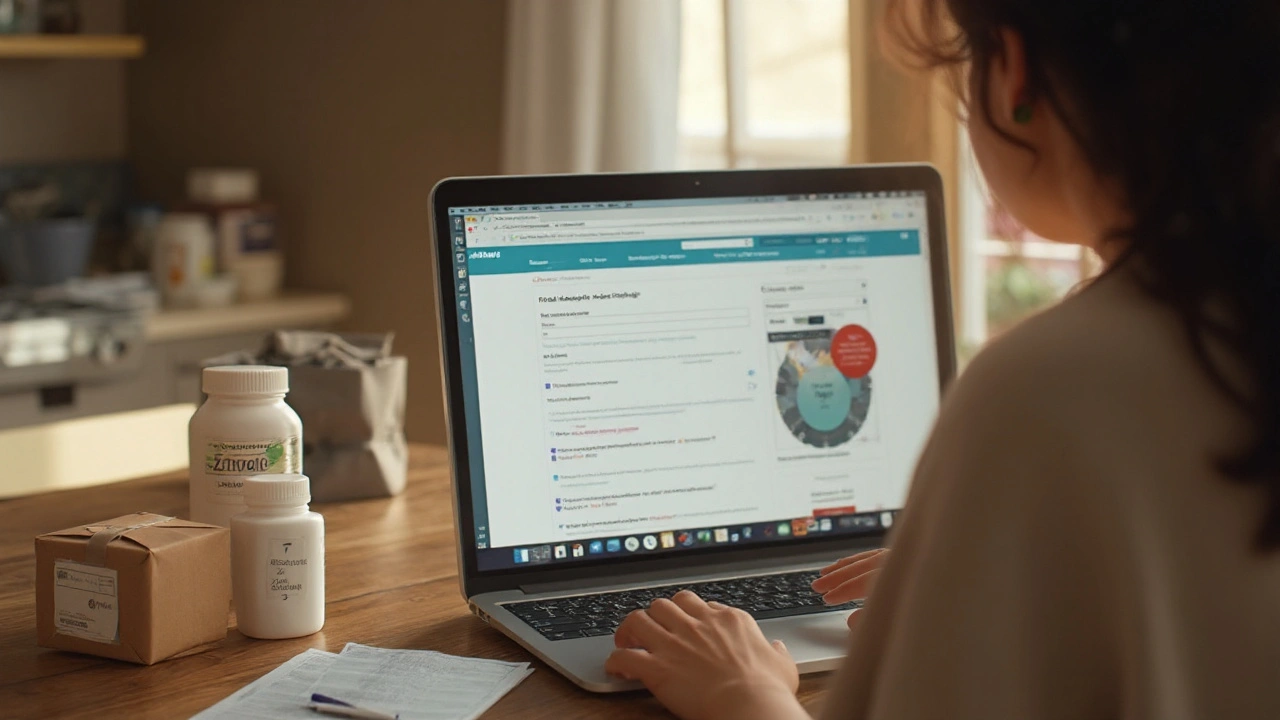
Allergy relief shouldn’t cost $20 for a tiny bottle. Generic Zyrtec-cetirizine-can cost pennies per dose online if you know where to look and what to avoid. Here’s how to buy generic Zyrtec online safely and cheaply in 2025 without getting stuck with fake pills, sketchy sellers, or surprise fees. I’ll keep it simple: what to buy, what to pay, how to check safety, which stores are legit, and a quick plan to place your order today.
If you’re here, your jobs are clear: find a trustworthy site, pay the lowest fair price, pick the right form (tablets, liquid, chewables), avoid scams, and make sure cetirizine actually fits your health needs. I’ve been through the seasonal sneeze gauntlet with two kids in Portland-spring pollen wrecks us-so I stock up smart and set it on subscription.
What you’re buying: cetirizine basics, forms, and who it helps
Cetirizine hydrochloride is the generic for Zyrtec. It’s a second-generation antihistamine used for allergic rhinitis (sneezing, runny nose, itchy eyes) and hives. It starts working in about an hour and lasts a full 24 hours. Compared to older antihistamines like diphenhydramine (Benadryl), cetirizine is much less sedating for most people, but a small number still feel drowsy. If you need a truly non-drowsy daytime option, fexofenadine tends to be the least sedating of the popular choices.
Common forms you’ll see online in the U.S. (OTC):
- Tablets: 10 mg, the standard adult dose. Biggest savings are here.
- Chewable tablets: 10 mg (adults/older kids), 5 mg (younger kids). Handy for kids who hate pills.
- Liquid (syrup): 1 mg/mL, usually in 4-16 fl oz bottles. Good for ages 2+ when pills aren’t an option.
Brand vs generic: Zyrtec and “store brand cetirizine” are held to the same FDA standards for active ingredient and performance. The fillers can differ, but for most people that doesn’t matter. If you ever reacted to one product’s dyes or sweeteners, pick a dye-free or specific formulation next time.
How it compares to the other go-tos:
- Cetirizine (Zyrtec): Strong on nose and eye symptoms; slight drowsiness possible. Once daily.
- Loratadine (Claritin): Also once daily; usually the mildest. Less potent for some people.
- Fexofenadine (Allegra): Least sedating. Great for daytime use; may be slightly less effective for severe symptoms versus cetirizine in some users.
- Levocetirizine (Xyzal): A related compound; similar effect to cetirizine with slightly different side effect profile; often pricier.
Who usually benefits: adults and kids with seasonal or year-round allergies who want all-day relief, especially when symptoms are more than “mild nuisance.” In my house, I keep 10 mg tablets for me and my older kid, plus liquid for younger ages during peak tree pollen season.
Prices, package sizes, and how to pay less in 2025
Fair prices change a bit through the year, but the best deals are consistent: bigger bottles and subscribe-and-save beats small packs. Here’s what “cheap but legit” looks like right now in the U.S.
| Form | Strength | Typical Package Sizes | Average Online Price Range (USD, 2025) | Estimated Cost per Dose | Notes |
|---|---|---|---|---|---|
| Tablet | 10 mg | 30, 90, 120, 180, 365 | $6-$12 (90 ct), $12-$25 (365 ct) | $0.03-$0.07 | Best value. Look for big-box store brands and bulk. |
| Chewable | 10 mg / 5 mg | 24, 48, 90 | $8-$18 | $0.10-$0.25 | Costs more for convenience. Helpful for kids. |
| Liquid syrup | 1 mg/mL | 4-16 fl oz | $9-$15 (4 oz), $16-$28 (8 oz) | $0.15-$0.30 | Check child dosing; mind shipping heat in summer. |
| Levocetirizine (alternative) | 5 mg | 30, 80, 90 | $10-$22 (80-90 ct) | $0.11-$0.28 | Similar effect; not needed if cetirizine works. |
| Loratadine (alternative) | 10 mg | 30, 90, 365 | $5-$20 | $0.03-$0.06 | Cheapest non-drowsy option for many people. |
| Fexofenadine (alternative) | 180 mg | 30, 90, 200 | $10-$28 | $0.08-$0.14 | Least sedating; great daytime choice. |
Price notes:
- Small packs (10-20 tablets) often cost more per dose than 90 or 365 counts. If you’ll use it for a whole season, buy big.
- House brands usually tie brand-name performance at a fraction of the price.
- Sales pop around spring allergy season and back-to-school. Stock up then.
Simple ways to pay less:
- Buy 180-365 counts if you’ll use daily. The unit price drops fast.
- Use retailer subscriptions (e.g., “subscribe & save”). Even 5-15% off matters on bulk.
- Load digital coupons before checkout; many big-box pharmacies post weekly coupons on OTC allergy items.
- Check unit price, not the sticker price. Aim for 3-7 cents per 10 mg tablet.
- Bundle with other OTC meds on free-shipping thresholds ($25-$35).
- Use HSA/FSA cards-OTC allergy meds are eligible in the U.S.
One more money thing: tablets have the lowest “waste.” Liquid can expire faster once opened, and chewables cost more per dose. If swallowing pills is fine, tablets are your budget ally.
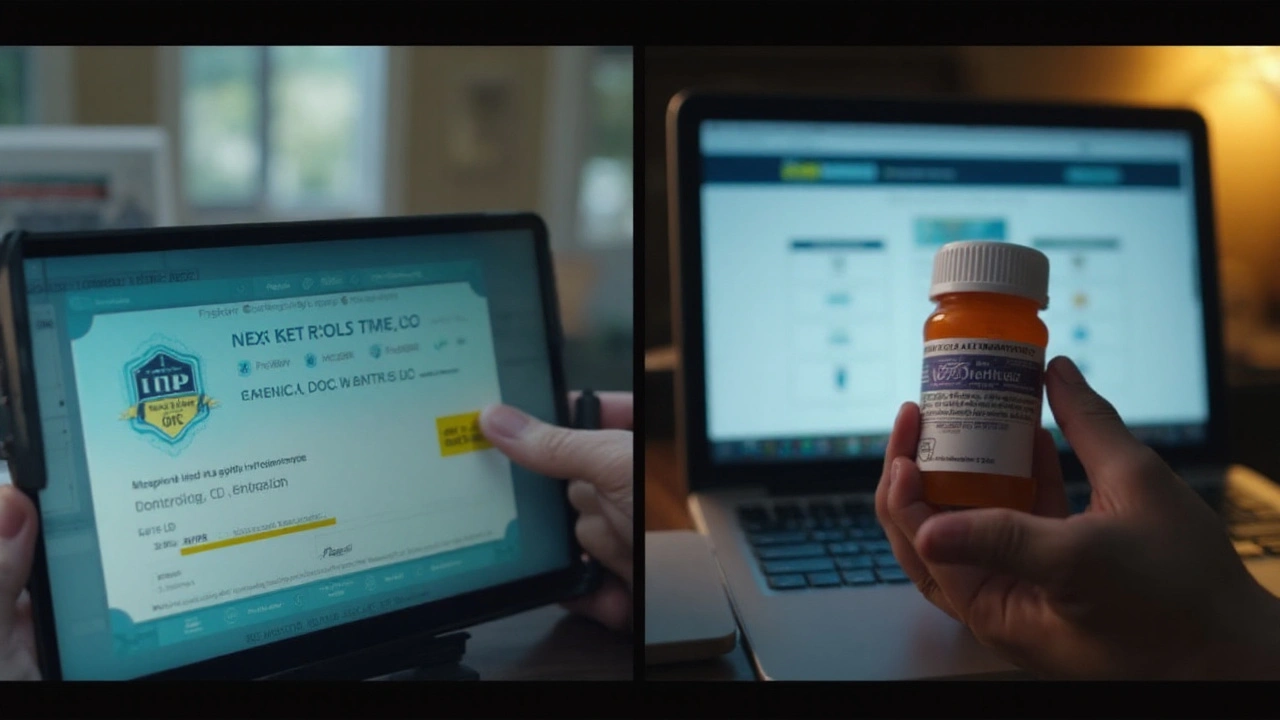
Safety check: dosing, side effects, and when to talk to a pro
Even with OTCs, a quick safety pause saves headaches. Here’s the snapshot aligned with FDA labeling and major medical groups like AAAAI:
Standard doses (do not exceed label directions unless your clinician says so):
- Adults and children 6+ years: 10 mg once daily.
- Children 2-5 years: 2.5 mg once daily; may increase to 5 mg daily if needed.
- Under 2 years: ask a pediatric clinician before use.
How to take it:
- Once per day at about the same time. If you feel groggy, try taking it at night.
- With or without food. Avoid mixing with alcohol or other sedating meds.
- If you have kidney disease, you may need a lower dose-ask your clinician first.
What you might feel:
- Common: mild drowsiness, dry mouth, fatigue, headache.
- Less common: stomach upset, itchy skin, restlessness.
- Rare but urgent: severe rash, swelling of face/tongue, trouble breathing-seek emergency care (possible anaphylaxis, which cetirizine will not treat).
Interactions and cautions:
- Do not combine with other antihistamines (doubling up raises side effects without better relief).
- Caution with sedatives, sleep meds, and alcohol-drowsiness can stack.
- Ritonavir and theophylline can tweak levels slightly; ask your clinician if you’re on complex regimens.
Pregnancy and breastfeeding:
- Pregnancy: Cetirizine is often considered a reasonable option if needed. Always discuss with your OB or midwife.
- Breastfeeding: Small amounts pass into milk and can make some infants sleepy or irritable. If you notice a change, check with your pediatrician and consider alternatives like loratadine.
When to call your clinician:
- Symptoms last longer than 3 weeks without improvement.
- You need more than the label dose to function.
- You have severe asthma symptoms with allergies-might need a different plan.
- You’re dealing with chronic hives or swelling-requires tailored care.
Credibility check: dosing and safety above track FDA’s OTC Drug Facts for cetirizine, the American Academy of Allergy, Asthma & Immunology (AAAAI), and standard pediatric dosing from Children’s Zyrtec labeling. If your personal history includes arrhythmias, severe kidney issues, or complex polypharmacy, ask first-even for OTCs.
Where to buy online safely and how to spot fakes
Most U.S.-based big retailers and licensed pharmacies sell genuine cetirizine. The trick is avoiding shady sites and paying a fair price.
Legit signals:
- U.S. retailers you already know (national chains, wholesale clubs, major online marketplaces) or licensed online pharmacies with clear state licenses.
- .pharmacy domains or listings approved by the National Association of Boards of Pharmacy (NABP).
- Clear contact info, return policy, and normal prices (not “90% off brand” in flashing banners).
Quick pharmacy verification:
- Look for the pharmacy’s state license number on their site.
- Check it against your state Board of Pharmacy’s license lookup.
- Cross-check with NABP resources like “Buy Safe Rx.”
Product checklist on the listing page:
- Active ingredient says “cetirizine HCl” and the strength (10 mg tablets).
- OTC Drug Facts image visible, with lot number and expiration on the bottle in product photos.
- Seller is the retailer itself (not a random third-party). If third-party, read recent reviews carefully.
- Return window of at least 14-30 days for unopened items.
Red flags to avoid:
- Sites shipping prescription drugs without a prescription.
- Prices that look impossible ($1 for 365 tablets) or listings with poor grammar and no Drug Facts images.
- International gray-market sites shipping “brands” you’ve never heard of with no U.S. labeling.
Shipping and handling tips (especially for liquids):
- Heat matters. In peak summer, choose faster shipping for syrups. Tablets tolerate heat better than liquids.
- Check arrival packaging: sealed bottle, intact safety seal, clear lot and expiration date. Keep a photo.
- If the bottle looks tampered with or the pills smell odd or crumble easily, don’t use it-request a refund and report to the seller and FDA MedWatch if needed.
Returns and taxes:
- Most retailers allow returns of unopened OTCs; opened meds usually aren’t returnable unless defective.
- Sales tax varies by state and retailer; factor it into final price.
I buy bulk tablets from a big-box store’s online site and set a 6-month subscription. It shows up before pollen does, and I’m not paying convenience markups in peak season.

Quick buying guide and smart savings checklist
Here’s the fast path from search to checkout.
Step-by-step:
- Choose your form: if you can swallow pills, pick 10 mg tablets for best value. For kids who can’t, choose liquid or chewables.
- Pick a licensed U.S. retailer or pharmacy. If in doubt, verify the pharmacy’s state license.
- Size up for savings: 90, 180, or 365 count. Calculate unit price; aim for 3-7 cents per tablet.
- Scan for coupons and subscribe options. Add to cart when the math makes sense with shipping included.
- On delivery: confirm the seal, lot, and expiration. Store in a cool, dry spot out of kids’ reach.
Smart savings checklist:
- Bulk bottle? Yes, if you’ll use it within a year.
- Store brand? Yes-same active ingredient.
- Subscribe? Worth it if you take it daily in allergy season.
- Coupon stacked? Apply before checkout.
- HSA/FSA card? Use it for eligible OTCs.
Not sure cetirizine is your best fit? Quick guide:
- Daytime focus and you’re sensitive to drowsiness → try fexofenadine first.
- Mild symptoms and want the cheapest stable option → loratadine in bulk.
- Strong, persistent symptoms or hives → cetirizine often works well; try at night if you feel groggy.
Mini‑FAQ
- Is generic really the same as Zyrtec? Yes. FDA requires generics to match brand for active ingredient and clinical effect.
- How long until it works? Often within 1 hour, with peak effect in 2-3 hours. Lasts about 24 hours.
- Can I take it with alcohol? Best not-both can make you sleepy.
- Morning or night? If you feel drowsy, take it in the evening; otherwise, timing is flexible.
- For kids? Follow age-specific dosing on the label; talk to a pediatric clinician if under 2 years.
- What if it’s not helping? Give it 2-3 days. If no real change, try a different antihistamine or add a saline rinse or intranasal steroid after talking to your clinician.
Troubleshooting and next steps
- Order delayed: Check tracking, then contact the retailer. If pollen is raging, consider a small stopgap pack at a local pharmacy while you wait.
- Price jumps at checkout: Remove third-party sellers. Stick with the retailer as the seller and re-check unit price.
- Package looks tampered: Do not use it. Photograph it, request a replacement/refund, and report if needed.
- Unexpected drowsiness: Switch dose to evening. If still groggy, try fexofenadine next.
- Symptoms break through daily: Combine with non-drug steps (shower after outdoor time, HEPA filter) and ask your clinician about adding an intranasal steroid.
- Rashes/hives persist: Chronic hives need clinician guidance; don’t escalate doses on your own.
Sources worth trusting for deeper info: FDA OTC Drug Facts for cetirizine, FDA’s BeSafeRx program for online pharmacy safety, AAAAI guidance on allergy meds, and state Board of Pharmacy license lookups. When in doubt, a quick call to your pharmacist can save you money and hassle.
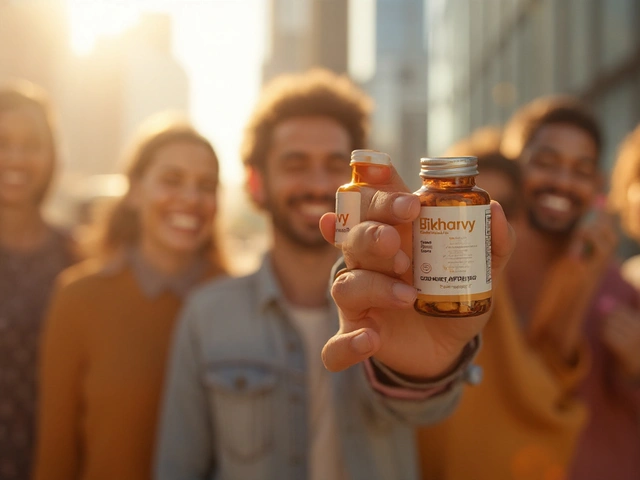
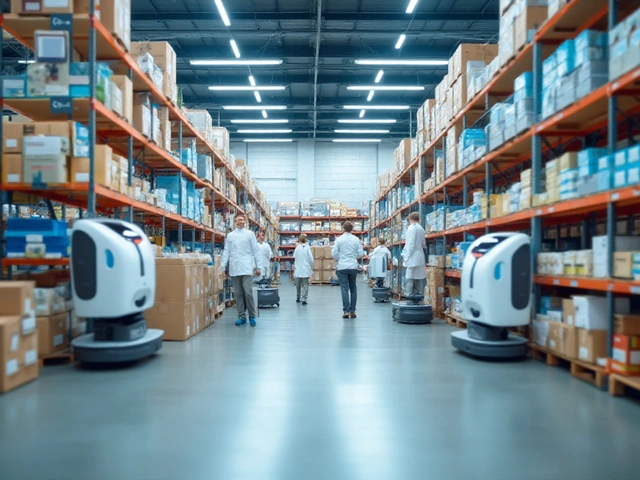

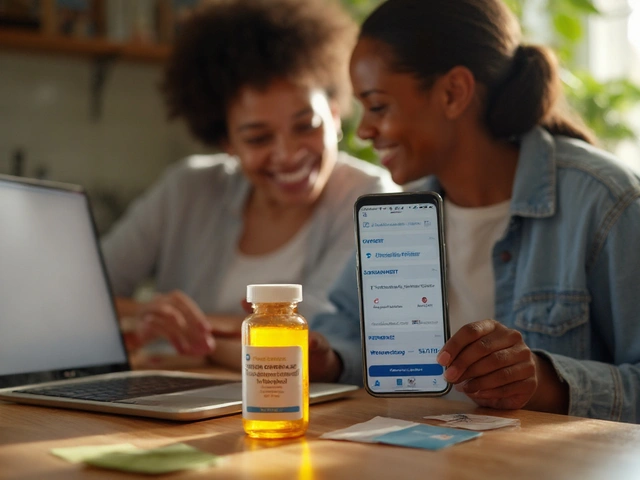
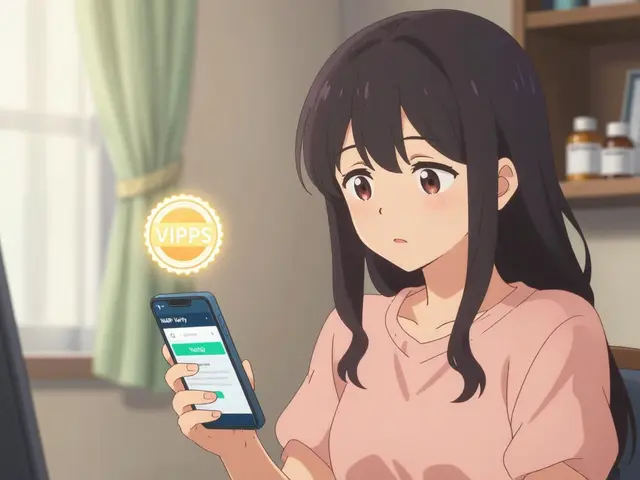
Comments (12)
Joshua Brown
Bulk cetirizine tablets save money and reduce hassle, especially if you take them every day during a season, so buy big and breathe easier.
I buy 180 or 365 counts for the household and it cuts the per-dose cost to pennies, which matters when you have kids or roommates, and it keeps me from running to the store every week for a tiny bottle.
Store brands are fine, the active ingredient is the same, and most big-box generics meet the same FDA specs as the brand-name product, so don’t pay the markup unless you have a specific sensitivity to an excipient.
Always check the lot number and expiration in the product photos on the listing, and if the seller won’t show a Drug Facts panel and a readable expiration, pass on that listing, it’s not worth the risk.
Tablets tolerate shipping heat better than liquid, so choose tablets for bulk orders unless you need syrup for a toddler, and then select faster shipping in summer months.
Use subscribe-and-save when your retailer offers it, stack digital coupons when they’re available, and use HSA/FSA cards if you have them to shave a few more dollars off.
When a big sale hits in early spring, add a bulk bottle to your cart and check the unit price rather than the sticker price, because the 30-count pack often looks cheap but is more expensive per dose.
If you ever feel unexpected drowsiness after switching generics, try taking it at night for a few days, and if that doesn’t help, swap to fexofenadine which tends to be least sedating for daytime use.
If you have kidney disease or are on complex meds, talk to your clinician about dose adjustments before you stockpile, that saves trouble later.
On arrival, photograph the seal and lot number, keep the box, and store the bottle in a cool, dry place out of kids’ reach, because opened liquids lose potency faster and chewables cost more per dose.
Check shipping sellers closely: if the listing is from a random third-party seller with absurd markdowns, opt for the main retailer itself to avoid gray-market product risks.
If a package looks tampered with or the pills are crumbly or have an off smell, stop and report it to the seller immediately and to FDA MedWatch if needed, because it protects you and others.
For kids, follow label dosing closely and keep liquid syrups labeled and away from other meds to prevent dosing mistakes, and write the child’s name on the bottle if you have multiple kids using different meds.
Combine med strategy with non-drug steps like HEPA filters, showering after outdoor time, and nasal saline rinses for better symptom control, that often reduces the need to up doses or stack antihistamines.
Finally, a simple buying checklist saves time: pick tablets if possible, buy 90+ counts for best per-dose value, verify the seller’s license when in doubt, and keep a calendar reminder to check expiration dates before using older stock, so your allergy season is handled and your wallet is not weeping.
andrew bigdick
Good call on unit price, that’s the number I always check first and it does the heavy lifting when comparing listings, no drama.
For families with mixed ages, splitting formats is practical: tablets for adults and chewables or syrup for little ones, and keep everything labeled so nobody takes the wrong thing.
Also, avoid stacking antihistamines unless a clinician advised it, it rarely helps and only ups side effects, plain and simple.
Shelby Wright
Bulk or bust, darling, but don’t be sloppy about safety, because fake pills are out there and they look convincing as hell.
Check pictures, read the tiny Drug Facts image like your life depends on it, and if the listing has weird grammar or a weirdly low price, walk away, because cheap can be a trap.
Shipping matters too, especially syrup in peak heat, so pay for faster shipping when it’s hot and keep receipts and pictures if anything looks off on arrival.
Also, if you ever see pills with odd color or texture or a smell that makes your nose scrunch, photograph it and get your money back, don’t be polite about it because health isn’t a suggestion.
Label the stash, rotate older bottles forward, and don’t mix medicated bottles in a drawer where someone might grab the wrong one on autopilot, that’s basic, non-negotiable housekeeping.
And if you feel like a generic makes you weirdly sleepy for days, stop using it and switch, life is short and nasal itch is not worth brain fog.
Ellen Laird
Bulk is the only civilized choice, obviously.
rafaat pronoy
Solid tips about photos and lot numbers, I always screenshot listings and keep receipts :)
Also, for liquid meds in summer I schedule delivery for early morning to avoid sitting on a hot porch, that’s saved a bottle or two.
sachin shinde
Price per unit is the metric people ignore at their peril, and it baffles me every time when someone posts a screenshot of a tiny pack like it’s a deal.
Read the Drug Facts, observe storage conditions, and for heaven’s sake check the seller field in the listing so you don’t buy from a random marketplace vendor with zero history.
Also, be precise with dosing for kids, using the measuring syringe included with syrup avoids gallons of confusion, and dosing must match the mg per mL printed on the label exactly.
Leon Wood
Love the checklist vibe, that’s how small wins stack into big savings and better health outcomes, so follow the plan and you’ll thank yourself later.
Micro tip, set a calendar reminder to reorder a week before your current bottle runs out, that prevents last-minute expensive buys when pollen peaks.
Also, share your subscribe links with family so everyone’s on the same refills schedule, it’s community-level efficiency and it’s super satisfying.
Stay optimistic and stock smart, you’ve got this.
George Embaid
For those in multiple time zones or outside the U.S., check local regulations and prices because import rules and taxes can change the math dramatically.
Also, cultural note: some markets have excellent store brands that are significantly cheaper than U.S. equivalents, so if you travel often, keep an eye on local pharmacy value.
Share legitimate pharmacy links with friends who struggle with seasonal allergies, it helps the community and reduces the panicked last-minute buying that drives up costs at peak.
Be kind and practical, the savings are better when spread around.
Meg Mackenzie
Don’t trust the miracle prices on sketchy overseas sites, those are the ones that give me the creeps and make me stockpile receipts like evidence, because safety systems get bypassed when profit comes first.
Every time I’ve seen a too-good listing it’s had altered photos or missing Drug Facts panels, and that pattern screams caution and bad actors.
Keep a small local backup pack even if you order in bulk online, because shipping delays are the perfect setup for a flare-up and nobody wants to be without relief on a bad pollen day.
Photos on delivery are non-negotiable, keep them in a folder with the order confirmation, and if the product looks off, escalate to the seller and keep copies of the exchange for reporting.
Big sales are tempting but don’t let shiny banners override common sense and verification steps, because once you’ve used a dodgy product, it’s a mess to untangle and it can affect trust in legit sources.
I personally avoid third-party marketplace sellers for meds and stick to pharmacy-owned storefronts, that habit saved me from a counterfeit chewable batch last season, and that felt like a small victory for personal hygiene and sanity.
Keep calm and verify everything, it’s boring but it keeps your family safe and that’s the only acceptable outcome.
Shivaraj Karigoudar
I write long notes about procurement and cold-chain logistics, so here’s a technical take that might help some people planning multi-city shipping and storage strategies for syrups and heat-sensitive formulations.
First, ambient temperature exposure during last-mile delivery can elevate internal product temperature beyond label-stated tolerances, especially in summer and in enclosed delivery trucks, and that degradation pathway is not always visible by simple inspection once the product reaches the consumer.
Second, the thermal inertia of bulk tablet containers is higher, so tablets experience smaller and slower temperature excursions which translates to better stability during transit compared to liquid syrups, and that is a primary reason tablets are recommended for bulk purchases.
Third, when distributing medications among household members, maintain a log that records lot numbers, arrival dates, and storage conditions in a simple spreadsheet or app so you can trace any adverse event back to a lot quickly and accurately, this is basic pharmacovigilance at home.
Fourth, consider regional distribution points or using a trusted pharmacy chain that consolidates shipments, because consolidating reduces transit time and handling events, which statistically lowers the chance of exposure to extreme conditions during delivery.
Fifth, when dealing with online marketplaces, the seller metadata and state license verification are vital data points and should be recorded before purchasing, since many platforms allow multiple vendors to list identical products with varying provenance.
Sixth, for those managing pediatric dosing, convert concentration and dosing instructions into milliliters per dose and print them clearly on a sticker affixed to the syrup bottle, to avoid caregiver confusion and dosing errors in real-world settings where stress and distraction are common.
Seventh, if you maintain a larger home stockpile, rotate inventory so that the earliest expiration dates are used first, and schedule periodic checks to ensure no bottle is stored near radiators, windows, or hot appliances, because ambient conditions are often overlooked in home settings.
Lastly, maintain a contact list including your retail pharmacist, local poison control center, and primary clinician in a single place so that if a supply or adverse event issue arises you have rapid access to professional guidance and can act decisively, which reduces harm and confusion.
andrew bigdick
Nice point about calendar reminders, I’ve set them for refill and they always save me from panic buys.
Subscription knocks the stress out of seasonal runs and keeps the household in rhythm, so it’s worth the small setup time.
rafaat pronoy
That log idea is neat and practical, I’ll try a simple spreadsheet for lot numbers and expirations :)
Also, labeling syringes after measurement helps when multiple caregivers are involved.